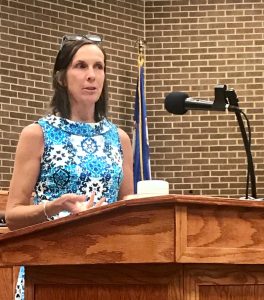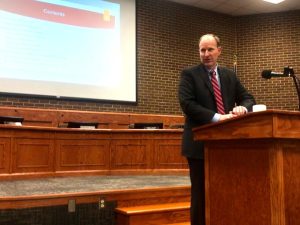
By Brandon Martin
A city reversion could lead to an approximate $3.3 million deficit for Henry County’s general fund, according to a presentation by Ann Shawver, a consultant to the county’s legal firm Guynn, Waddell, Carroll and Lockaby, P.C. of Salem, Va.
Shawver said that in a situation where the City of Martinsville becomes a town inside of the county, the new town residents would pay taxes for real estate, personal property, machinery and tools and for public service corporations to both the town and the county.
Other types of taxes such as a meals tax; however, would be areas where the county would lose revenue since the taxes would not be paid to both localities.
“I did a lot of number crunching at a detailed line item level of all of the revenues to the county’s general fund,” Shawver said. “The general fund total is estimated at $10,736,015 and the biggest piece of that is general property taxes.”
In addition to the loss of revenue, the county would also incur new expenses.
Shawver said that the biggest expense would be education. She said judicial administration and public safety expenses also would be substantial.
“The punchline here is an increase in almost $14.1 million (in expenditures),” Shawver said. “There’s a lot more expenditure than revenue that we expect to come over.”
These calculations were only made from known variables, according to Shawver, who said that there also are unknown variables that need to be addressed before the county would have a full picture of the cost of reversion.
Some examples of these unknowns were the potential changes that would be made to buildings, matching pay scales for employees that would be onboarded to the county’s payroll, compensation for the new constitutional offices that would become to county’s responsibility, and an increase in town residents using county services.
When new revenues and expenditures are compared, “we see there is, unfortunately, a fairly sizable deficit of $3.3 million,” Shawver said. “This does not include these potentials, and this also does not consider the long-term impact of any annexation.”
With the process of reversion comes the end of the annexation moratorium, with the new town able to claim parts of the county within its borders after a two-year period, according to Jeremy Carroll, a partner with the county’s legal team.
“The ultimate goal, I believe as it usually is in any reversion, is not necessarily reversion. It’s the annexation that follows,” County Administrator Tim Hall said. “We have no idea how to capture those costs yet.”
There are some general areas that the county would lose revenues because of annexation, according to Shawver.
“Should annexation occur, there would be loss of revenues, the utility tax, the meals tax, the lodging tax,” Shawver said. “Basically, all of these transactional consumer-generated taxes.”
Trying to close the gap using only real estate taxes would result in a 10 percent additional tax for county residents, Shawver said.
According to a report presented by Stephen Piepgrass, also from the city’s legal firm, Troutman Sanders, the county’s revenues would increase by approximately $28.7 million, but their expenses also would increase by approximately $30.6 million. The proposal to solve this $1.9 million difference would be to increase the current county real estate tax of $0.555 by five cents.
“There is a reduction in the current city tax rate of 1.0621 to 0.4571, but then the difference is made up by the five-cent increase in county taxes,” Piepgrass said. “Because town residents would pay county taxes, the end result is a net wash.”
Piepgrass reiterated that this tax plan is just a proposal, and after negotiations, the numbers could change.
“I think the expectation on the city’s part that this whole process would only lead to a five-percent increase to real estate tax for county residents — I think that is optimistic,” Hall said following the presentation. “It’ll probably be closer to 10-cents.”
The county also could raise other taxes or implement new taxes such as a cigarette tax, according to Shawver.
“When we have a budgetary gap that we need to close, we can raise additional revenues, we can curtail our spending or we can do a little bit of both,” Shawver said.
For every one percent of expenses that could be cut, “we could save about $141,000,” she added.
These numbers did not include revenues that could potentially be collected if the county and city school systems merge. While expenses would be around $21.2 million, according to Shawver, revenues would be about $22.4 million, which is a surplus of about $1.2 million for the county.
“I need to caution county officials from thinking that $1.2 million can help close that $3.3 million gap because I think we need to probably work through the process and see what is involved on the salary piece of the school operations and other aspects before we could necessarily count on this,” she said.
Another area that was not addressed in the numbers by Shawver are “properties that come over to the county that have debt on them.” She said the details of debt service would be negotiated during the process, but if the county does indeed incur some of the city’s debt then “that is going to widen the gap.”
Hall also expressed concern about the unknown variables.
“They all have associated costs with them, and we have no idea what those costs would be,” he added.
Dr. J. David Martin, of the Iriswood District, said that he was interested in some of the known variables presented in the reports.
“First, the vitality of the city in terms of their finances and their use of fund balance. That was interesting information,” he said.
Reed Creek Supervisor Tommy Slaughter agreed with Martin’s assessment.
“I think that they put out that they use a lot of it (fund balance) but they don’t use as much as they advertise and that was kind of eye opening,” Slaughter said.
At a November 2019 city council meeting, the city said it expected to have to use the city’s fund balance to balance the budget in the future, a move that would increase rates in fees or result in significant reduction of services to its citizens.
“The city council sets the policy for the city regarding the fund balance and cash reserves,” City Manager Leon Towarnicki said at the time. “We do have a cash reserve for the utilities and a fund balance for the general fund and through that, it’s $13 million or $14 million, so the perception that the city is going broke is simply not the truth. The city has money and that financial reserve is what keeps the city stable. You don’t want to get into a situation where you start spending that reserve and you use that to balance the budget.”
During the county’s July 29 presentation, Shawver gave a financial snapshot of the city.
“Their policy says that they always want to have 10 percent of their annual budget sitting in the bank, if you will, for their fund balance,” Shawver said. “In most cases, they’ve been above the 10 percent level. Sometimes more like 12-13 percent. We only see one year in this time frame where they fell below that policy amount.”
Ideally, Shawver said a community would adopt a budget with revenues that are adequate to cover expenditures. When this doesn’t happen, typically the locality will borrow from the fund balance, she added.
“When communities do that a lot, that can be a sign of fiscal distress,” Shawver said.
For this purpose, Shawver said that she analyzed the actual amount the city used of its fund balance over the past 10 years.
“While the city planned — in adopting its budget — a median use of fund balance of about $1 million, as the city moved through its year, it added additional activities. Typically, its final budget was calling for use of fund balance up to $1.8 million. Indeed, its actual use of fund balance has only been about $300,000 in the median. Our conclusion from that is that the city is not nearly as reliant on this fund balance as it may represent at times, or as it seems to be at the time that it adopts its budget.”

Carroll offered additional information on the overall process of reversion moving forward.
After the city decides to file their petition and evidence with the Commission on Local Government, the county will have an opportunity to do the same, according to Carroll.
Following a two- to three-day hearing, the commission will file a report with their conclusion. Once they have filed the report, the state Supreme Court will appoint a three-judge panel or court to preside over the case. Whatever the decision, it can be appealed to the Supreme Court.
“The city would have 21-days if they decide to opt out of reversion at that point,” Carroll said, adding that the panel of judges would remain in place for 10 years to oversee the process.
Carroll said that the city and county could meet at any point during the process to negotiate a settlement which would have to be approved by the commission.
“While the reversion process has started, that’s not the only way to bridge the gap between the city and the county,” Carroll said. “Other possibilities would be simply school consolidation or consolidation of constitutional officers and courts. That could be short of full-blown reversion from city to town status.”




